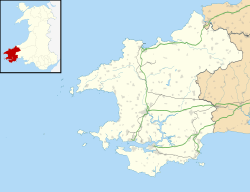| Sardis | |
|---|---|
 Cottages in Sardis | |
Location within Pembrokeshire | |
| Community | |
| Principal area | |
| Preserved county | |
| Country | Wales |
| Sovereign state | United Kingdom |
Sardis is a small village in Pembrokeshire, belonging to the Community of Saundersfoot. It lies just south of Stepaside and northwest of Wisemans Bridge in the Pembrokeshire Coast National Park. The area is busier during the summer months when tourists stay at the nearby caravan parks in Wisemans Bridge and Amroth. It contains a small chapel called Sardis Congregational Church, established in 1808 in the northern part of the village. [1]

